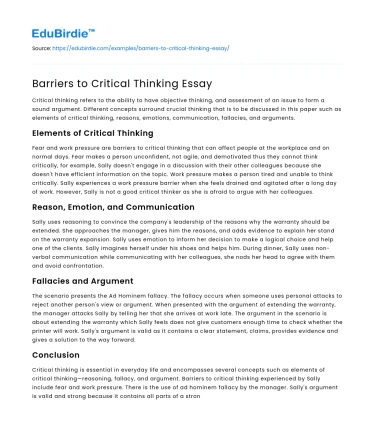Critical thinking refers to the ability to have objective thinking, and assessment of an issue to form a sound argument. Different concepts surround crucial thinking that is to be discussed in this paper such as elements of critical thinking, reasons, emotions, communication, fallacies, and arguments.
Elements of Critical Thinking
Fear and work pressure are barriers to critical thinking that can affect people at the workplace and on normal days. Fear makes a person unconfident, not agile, and demotivated thus they cannot think critically, for example, Sally doesn't engage in a discussion with their other colleagues because she doesn't have efficient information on the topic. Work pressure makes a person tired and unable to think critically. Sally experiences a work pressure barrier when she feels drained and agitated after a long day of work. However, Sally is not a good critical thinker as she is afraid to argue with her colleagues.
Save your time!
We can take care of your essay
- Proper editing and formatting
- Free revision, title page, and bibliography
- Flexible prices and money-back guarantee
Reason, Emotion, and Communication
Sally uses reasoning to convince the company's leadership of the reasons why the warranty should be extended. She approaches the manager, gives him the reasons, and adds evidence to explain her stand on the warranty expansion. Sally uses emotion to inform her decision to make a logical choice and help one of the clients. Sally imagines herself under his shoes and helps him. During dinner, Sally uses non-verbal communication while communicating with her colleagues, she nods her head to agree with them and avoid confrontation.
Fallacies and Argument
The scenario presents the Ad Hominem fallacy. The fallacy occurs when someone uses personal attacks to reject another person's view or argument. When presented with the argument of extending the warranty, the manager attacks Sally by telling her that she arrives at work late. The argument in the scenario is about extending the warranty which Sally feels does not give customers enough time to check whether the printer will work. Sally's argument is valid as it contains a clear statement, claims, provides evidence and gives a solution to the way forward.
Conclusion
Critical thinking is essential in everyday life and encompasses several concepts such as elements of critical thinking—reasoning, fallacy, and argument. Barriers to critical thinking experienced by Sally include fear and work pressure. There is the use of ad hominem fallacy by the manager. Sally's argument is valid and strong because it contains all parts of a strong argument. Critical thinking enables us to make informed decisions.






 Stuck on your essay?
Stuck on your essay?

